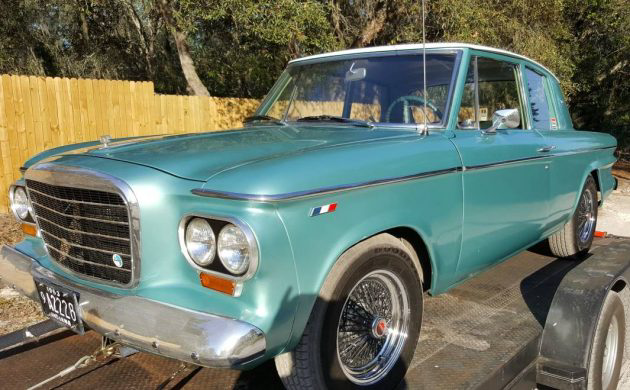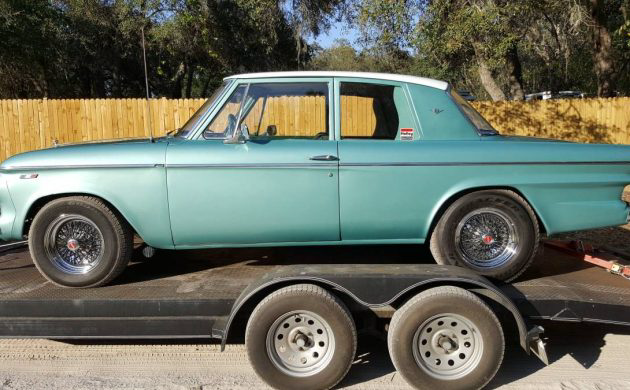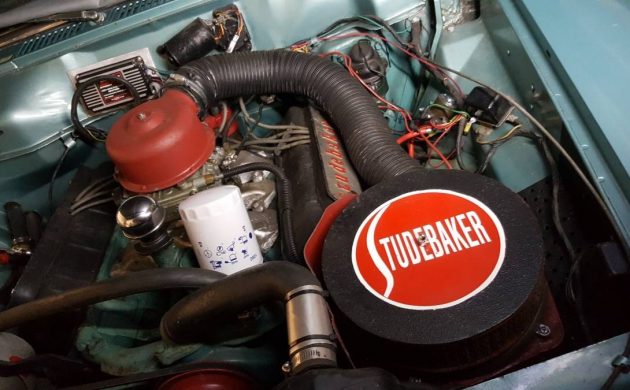Update – The seller has updated their ad to state that this Lark is an R2 clone. It’s supercharger is stated to be a McCullough blower.
In 1963 Studebaker added the R1 and R2 engine options to the vehicle range, and the R2 engine, in particular, boosted the performance of the Lark. However, it was never enough to save the company, which closed only three years later. This 1963 Lark is being offered for sale here on Craigslist. It is located in Port Charlotte, Florida, and is being offered with a clean title. The owner of this Lark has set a sale price of $10,500, but he may be willing to consider a trade of the right vehicle.
The Lark does present very nicely, and the owner stresses that it is rust-free. The seller also states that there has been a repair on the driver’s rear quarter, but it still looks pretty good. One of the things that I’m not that fond of is the wheels. I think that these would need to be changed, but that’s personal preference. The interior is also said to be original, but unfortunately, we don’t receive any shots of it to confirm condition.
Introduced in 1963, the R2 engine option as fitted to this Lark provided a nice little performance boost. The standard 289ci Studebaker V8 was no slouch as an engine, but Studebaker upped the stakes by lowering engine compression and then fitting a Paxton SN-60 supercharger which delivered 6 lbs of boost to the engine. The standard 289 delivered 225hp, and initially, Studebaker was quite coy about quoting power figures. Eventually, they confirmed that the R2 engine delivered 289hp. This Lark is fitted with the R2 engine, which is backed by the T-10 4-speed manual transmission. The seller states that the car runs and drives well. I must say that for a 54-year-old car, the engine bay looks remarkably clean and tidy.
Assessing a value on this Lark is quite difficult, as 1963 models optioned with the R2 engine and manual transmission don’t hit the market that often. I’ve looked back on some historical sales over the last couple of years, and have found only a few that have been sold. Those that I’ve found have been in about the same sort of condition as this one, and the average price at auction has been around $17,500. This could be quite a good buy, and it would also be a nice thing to enjoy on a weekend.





there isn’t anything wrong with those wheels, the right wire wheels add the cool factor
The baskets come off. I wasn’t in aw or taking to cleaners the man was dying and didn’t want his kid to have it so I bought it. Doing the best I can to describe it. I’m not a flipper. I just don’t need it. I rather trade it for 50’s Chevy its a really clean body and half of you guys sell 4 doors in the teens and put everyone else’s motors in them. I was hoping people might help in telling what it was instead of being such jerks about. I never thought it was and R2. 6 cyl auto not a V8. Hell its a nice fast car that runs and drives and its a two door.
Looks like the advertiser undercut you a bit Adam. Ad was revised 20 hours ago as of this writing, there are now shots of the interior, and the word CLONE (sic) in the opening sentence. Looks like this is a case where the seller may not be well informed about these and got educated by email as to what he really has (a notion that some here scoff at….sigh).
He also notes that the firewall numbers decode to a six cyl engine. This is a neat car in some ways, but it’s one of those orphan brands that can be difficult to find a buyer for these days. Perhaps the auction he mentions will be his teacher. Those few dedicated to a brand can have a narrow set of criteria to part them from their money. Were this a factory R2 the list of interested folk would be much longer.
Just include the word “clone” on your poster at the car shows (good for plenty of conversation) , take the 7K difference and buy another nice Stude!
Lose the wheels, lose the gonky oversize tires, lose the steering wheel wrap and the “necker knob” (you naughty lover-boy you), give it a decent paint job that’s shiny at least, spend about $5 grand on the interior, get rid of the Studebaker stickers and whatever is going on with the rear side windows and you’ve still got a car that nobody under the age of 70 would want to be seen in.
It’s also NOT a 4 speed. The one shot showing the steering wheel shows a column shift automatic, and there is also no clutch pedal.
There is no supercharger either
You might want to look at the ad itself.
Look close Unk, it’s an leaf blower ;) Even has a perforated panel to dump the exhaust in to the wheel well.
How about we strike the “super” and just call it a “charger”? :)
Ther’s a lot of things wrong on this ‘R 2″ Lark. The motor looks to be an older 289 except there is an oil filter on top. Studebaker Lark and Hawk Jet thrust motors had a center top mount for the superchargers, Avanti had the side mount on the passenger side. Who knows where the supercharger enclosure came from, not factory by any stretch of the imagination. To my knowledge, no Larks had the red/white/blue badging mounted on the side of the fenders behind the headlights. Finally, what is with the roofline on the rear windows? This is a “wanna-be” car.
That painted section on the rear glass appears to be reminiscent of the elongated S that Studebaker used for one of it’s logos. Some owner probably thought they were making a styling statement.
The engine is out of a 62 or older. Late 62-64 had full flow oil filters that were low on the block. Not even close to a R2.
There’s a lot of things wrong on this ‘R 2″ Lark. The motor looks to be an older 289, valve covers, except there is an oil filter on top. Studebaker Lark and Hawk Jet thrust motors had a center top mount for the superchargers, Avanti had the side mount on the passenger side. Who knows where the supercharger enclosure/air cleaner came from, not factory by any stretch of the imagination. I’ve never seen a Studie supercharger mounted in that fashion. To my knowledge, no Larks had the red/white/blue badging mounted on the side of the fenders behind the headlights. Finally, what is with the roofline on the rear windows? This is a “wanna-be” car.
Another curber who knows little to nothing about their latest purchase, is in such a hurry to post it up that it is still on the trailer, and then writes misleading information on the car. Anyone else wish that there was some kind of legal deterrent for these guys? And yeah, I get caveat emptor, but outright lies and deception go a bit too far these days with the flippers.
Having had a few R-2 cars in my 50 years of collecting & repairing Studebakers, I can tell you that isn’t even close to being a Paxton, or even a McCulloch supercharger. All R-2 cars had a belt drive for the blower, driven off the crankshaft. This car has a very unusual vertical shaft blower, belt driven off what appears to be a starter motor located in the left front wheel well. I wonder how much belt slippage will occur when water spray off the tire hits that moving belt!
A CLONE by definition is an exact representation of the original. I’m sorry to say this ain’t even close. I suspect that blower is more like a centrifugal fan, since the starter motor can’t spin it fast enough to achieve the needed PSI boost like in the Paxton unit, that revs it’s centrifugal fan at speeds approaching 40,000 RPM!
Look at the flex ducting used to connect the blower to the carb; it appears to be the standard 4″ air ducting used on many 50s & 60s car heating ducts. It’s not designed for pressurized air flow. If it was ever pressurized from a genuine high revving supercharger, it would expand & ultimately bust at the seam.
The supercharger bears a passing resemblance to the late 30’s McCollough superchargers used on Ford flathead V-8’s. Certainly not a VS57 or SN60 that Studebaker used.
Starter motor driven? Can someone school me on how this works? Would it be on all the time? Only one speed leaning it out at idle? Has cool look, but I would think any old school performance junkie would be flat on their backs laughing their a$$es off.
nrg8,
I’m assuming there is a switch somewhere to turn the starter motor on, might be on the dash, perhaps on the gas pedal linkage. And you betcha, when I realized what was under the hood, I began laughing!
I suspect this was created by someone who had some spare pieces and parts lying around, and a lot of spare time to experiment. I seriously doubt it provides a boost above atmospheric pressure. But it probably does lessen the vacuum/suction in the air intake going into the carb.
And speaking of carbs, that doesn’t appear to be a pressurized carb, so if it did get a positive pressure boost, it would likely be spurting fuel all over the place.
Same old story, probably bought at a car show. Car looked presentable. Seller got flipper circling the bait. Yeah that’s the rare R2(d2) performance package. Asked a nada value. Flipper countered by half. Seller played it up a bit, probably squeezed 2k more. But only greeny leafy spendy money. Probably thought he got a smoking deal. Oh well can’t win ’em all.
I’m not sure hitting the switch on the blower drive motor would turn the blower fast enough to make so much as a peep, let alone a supercharger whine. The drive might make a little groan.
Sayyyyy… I’ve got a blower off of a Rolls Royce Dart 552-7R that came off of an F-27…
You mean the driver would let out a painful groan! Also a starter motor is not intended for continuous duty so it would quickly overheat!
Gives me ‘nuther idear. The PT-6 starter/generator is a continuous unit… only it’s 28VDC. Man, you can really put some bucks into this operation.
Yep…the fender tag is from a 64 and of course in the wrong place….kinda your first clue….
When I was in Peru 30 years ago, in the typical tourist areas there were ladies who carried bellows with them for the “lowland people”, who were having a hard time with the lack of air. They would place the bellows [with 2 holes in the end instead of one] into your nostrils and pump the bellows to increase the amount of air [and oxygen] into your lungs so you didn’t pass out! And yes, it does work!
I think this unit may have been designed for very high altitude situations [think Nepal, Peru, Ecuador, etc.] where the air is so thin it’s almost impossible to start a diesel motor. At extreme elevations, because the final compression ratio is not high enough to ignite diesel fuel, they use a pressure booster to push air into the engine intake manifold.
Because the engine is not rotating fast enough to power the blower, they use a separate electric motor to power the blower. These blowers are intended to provide a small boost up to the typical 14.5 PSI atmospheric pressure we are used to. Once the engine is running, they turn the blower motor off.
I remember seeing McCulloch blowers on gasoline powered construction equipment, and found out McCulloch actually made a crankshaft driven low-pressure booster designed to run all the time, for gasoline motors in the Andes highlands, to provide needed horsepower equal to what the engines produced at sea level.
Bill,
Very interesting but I don’t think this car made it to Peru. I know there were many different types of McCulloch superchargers. I have no idea where the Studebaker came from on the valve covers. The engine color is 56-57 but it could be anything from 55-62. Without see engine number there is no way to tell if it is a 289 or 259.
Vince,
I agree, the car was probably never south of the border, but the blower might have been, or was used in places like a hotel high up in the Rockies.